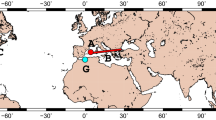Summary
Microseisms recorded by short-period vertical-component seismographs in a network of permanent and temporary stations in Sweden are investigated by means of their power spectra. The geographical distribution of the microseisms is explained in terms of models involving line sources. A good fit to the observations is obtained by locating the line sources along the surrounding oceanic coasts. The Norwegian west coast is of dominant importance for medium- and long-period microseisms, whereas for the short-period ones also coasts of smaller sea basins, as the Baltic Sea and the Skagerrak, are of significance. As a consequence, it is found that short-period microseisms are largest at stations on or near oceanic coasts, and that the smallest microseisms occur at inland stations.
Similar content being viewed by others
References
M. Båth,An investigation of the Uppsala microseisms, Thesis Uppsala Univ. (1949), 168 pp.
M. Båth,The distribution of microseismic energy with special reference to Scandinavia, Arkiv f. Geofysik, Kungl. Svenska Vet.-Akad.1 (1951), 359.
M. Båth,Seismic recording possibilities in Sweden, Res. Inst. Nat. Def., Stockholm, Report A 4466-4721 (1965), 22 pp. + 10 figs.
H. Bungum, L. Bruland andE. Rygg,Seismic noise structure at the Norwegian seismic array, Seism. Obs. Bergen, Sci. Rep.4 (1969), 38 pp.
E. J. Douze,Short-period seismic noise, Bull. Seism. Soc. Amer.57 (1967), 55.
N. R. Draper andH. Smith,Applied Regression Analysis, J. Wiley and Sons, New York (1966), 407 pp.
K. Hasselmann,A statistical analysis of the generation of microseisms, Rev. Geophys.1 (1963), 177.
E. S. Husebye andB. Jansson,Application of array data processing techniques to the Swedish seismograph stations, Pure and Appl. Geophys.63 (1966), 82.
R. T. Lacoss, E. J. Kelly andM. N. Toksöz,Estimation of seismic noise structure using arrays, Geophys.34 (1969), 21.
M. S. Longuet-Higgins,A theory of the origin of microseisms, Phil. Trans. Roy. Soc., LondonA 243 (1950), 1.
F. I. Monakhov,Microseisms at the bottom of the Baltic Sea and in the northern part of the Atlantic Ocean, Izv. Acad. Sci. USSR, Geophys. Ser. No. 7 (1962), 573 (Engl. ed.).
T. A. Santô,Energy sources of microseisms in Sweden, Ann. di Geofis.15 (1962), 335.
L. P. Vinnik, A. S. Deniskov andG. D. Kon'kov,Structure of microseisms in the 1 cps range, II. Results of observations, Izv. Acad. Sci. USSR, Phys. Solid Earth No. 8 (1967), 500 (Engl. ed.).
Author information
Authors and Affiliations
Rights and permissions
About this article
Cite this article
Kulhánek, O., Båth, M. Power spectra and geographical distribution of short-period microseisms in Sweden. PAGEOPH 94, 148–171 (1972). https://doi.org/10.1007/BF00875677
Received:
Issue Date:
DOI: https://doi.org/10.1007/BF00875677




